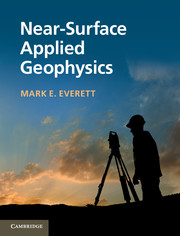Book contents
- Frontmatter
- Contents
- Preface
- Acknowledgments
- 1 Introduction
- 2 Data analysis
- 3 Magnetics
- 4 Electrical resistivity method
- 5 Induced polarization and self-potential
- 6 Seismic reflection and refraction
- 7 Seismic surface-wave analysis
- 8 Electromagnetic induction
- 9 Ground-penetrating radar
- 10 Emerging techniques
- 11 Linear inversion
- 12 Non-linear inversion: local methods
- 13 Non-linear inversion: global methods
- Appendix A Shannon sampling theorem
- Appendix B Solution of Laplace’s equation in spherical coordinates
- Appendix C The linear τ–p transformation of seismic data
- Appendix D Horizontal loop over a conducting halfspace
- Appendix E Radar TE waveguide mode equations
- References
- Index
- Plate section
8 - Electromagnetic induction
Published online by Cambridge University Press: 05 April 2013
- Frontmatter
- Contents
- Preface
- Acknowledgments
- 1 Introduction
- 2 Data analysis
- 3 Magnetics
- 4 Electrical resistivity method
- 5 Induced polarization and self-potential
- 6 Seismic reflection and refraction
- 7 Seismic surface-wave analysis
- 8 Electromagnetic induction
- 9 Ground-penetrating radar
- 10 Emerging techniques
- 11 Linear inversion
- 12 Non-linear inversion: local methods
- 13 Non-linear inversion: global methods
- Appendix A Shannon sampling theorem
- Appendix B Solution of Laplace’s equation in spherical coordinates
- Appendix C The linear τ–p transformation of seismic data
- Appendix D Horizontal loop over a conducting halfspace
- Appendix E Radar TE waveguide mode equations
- References
- Index
- Plate section
Summary
The electromagnetic (EM) induction method, traditionally used for mining, groundwater, and geothermal exploration and geological mapping (Grant and West, 1965; Nabighian, 1988; 1991), is growing in popularity for near-surface geophysical applications (McNeill, 1990; Nobes, 1996; Tezkan, 1999; Pellerin, 2002; Fitterman and Labson, 2005; Everett, 2012). The controlled-source variant of the method utilizes low-frequency (~ 1–100 kHz) time variations in electromagnetic fields that originate at or near the surface and diffuse into the subsurface. The ground-penetrating radar (GPR) technique is distinct from the EM induction method in the sense that the former utilizes a higher frequency range > 1 MHz for which wave propagation, rather than diffusion, is the dominant energy transport mechanism. The diffusive regime is marked by the requirement σ >> ωε where σ [S/m] is electrical conductivity, ω [rad/s] is angular frequency, and ε [F/m] is dielectric permittivity. The latter plays no physical role in the EM induction method. Instead, EM induction measurements respond almost entirely to the bulk subsurface electrical conductivity and, in particular, the spatial distribution of highly conductive zones (Everett and Meju, 2005). Instrumentation is readily available, easy to use, and reliable. Electric fields are sensed by pairs of grounded electrodes, i.e.voltmeters, while time-variations of magnetic fields are most commonly sensed using induction coils.
Introduction
The electrical conductivity structure of the subsurface, as determined from EM induction measurements, can be interpreted in the context of a wide variety of potential targets and application areas, see Table 8.1. Fundamentally, EM methods respond with good sensitivity to fluid type, clay content, and porosity.
- Type
- Chapter
- Information
- Near-Surface Applied Geophysics , pp. 200 - 238Publisher: Cambridge University PressPrint publication year: 2013
- 2
- Cited by



